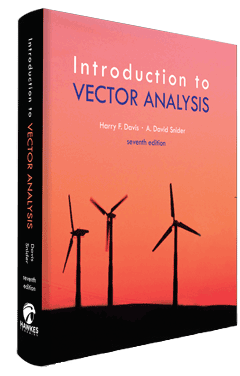
Introduction to Vector Analysis
By Harry F. Davis and Arthur David Snider
Instructors
Request Review CopyStudents
Buy PrintOverview
Introduction to Vector Analysis, in its seventh edition, has always enjoyed a reputation for expository excellence. The text is both a learning manual as well as a reference manual. It is based on a dual geometric-analytic approach to each topic of discussion. The concepts and theorems are first visualized and understood heuristically, and then are reduced to an algebra-calculus framework for computation or mathematical scrutiny. The text is unique in its presentation of the Laplacian and the vector potential and can be used at several levels. The first four chapters constitute a compact one-semester introduction to the subject. Chapter five and the appendices address deeper topics in differential geometry, potential theory, physics, and engineering.
Products
Formats: Textbook, Student Solutions Manual
| Product | ISBN |
|---|---|
| Student Solutions Manual | 978-1-932628-31-9 |
| Textbook | 978-0-697-16099-7 |
Table of Contents
- Chapter 1: Vector Algebra
- 1.1 Definitions
- 1.2 Addition and Subtraction
- 1.3 Multiplication of Vectors by Numbers
- 1.4 Cartesian Coordinates
- 1.5 Space Vectors
- 1.6 Types of Vectors
- 1.7 Some Problems in Geometry
- 1.8 Equations of a Line
- 1.9 Scalar Products
- 1.10 Equations of a Plane
- 1.11 Orientation
- 1.12 Vector Products
- 1.13 Triple Scalar Products
- 1.14 Vector Identities
- 1.15 Optional Reading: Tensor Notation
- Chapter 2: Vector Functions of a Single Variable
- 2.1 Differentiation
- 2.2 Space Curves, Velocities, and Tangents
- 2.3 Acceleration and Curvature
- 2.4 Planar Motion in Polar Coordinates
- 2.5 Optional Reading: Tensor Notation
- Chapter 3: Scalar and Vector Fields
- 3.1 Scalar Fields: Isotomic Surfaces: Gradients
- 3.2 Vector Fields and Flow Lines
- 3.3 Divergence
- 3.4 Curl
- 3.5 Del Notation
- 3.6 The Laplacian
- 3.7 Optional Reading: Dyadics: Taylor Polynomials
- 3.8 Vector Identities
- 3.9 Optional Reading: Tensor Notation
- 3.10 Cylindrical and Spherical Coordinates
- 3.11 Optional Reading: Orthogonal Curvilinear Coordinates
- Chapter 4: Lines, Surface, and Volume Integrals
- 4.1 Line Integrals
- 4.2 Domains: Simply Connected Domains
- 4.3 Conservative Fields: The Potential Function
- 4.4 Conservative Fields: Irrotational Fields
- 4.5 Optional Reading: Vector Potentials and Solendoidal Fields
- 4.6 Oriented Surfaces
- 4.7 Surface Integrals
- 4.8 Volume Integrals
- 4.9 Introduction to the Divergence Theorem and Stokes' Theorem
- 4.10 Optional Reading: Introduction to the Transport Theorems
- Chapter 5: Advanced Topics
- 5.1 The Divergence Theorem
- 5.2 Green's Formuals: Laplaces's and Poisson's Equations
- 5.3 The Fundamental Theorem of Vector Analysis
- 5.4 The Point-Slope Form
- 5.5 Stoke's Theorem
- 5.6 The Transport Theorems
- 5.7 Matrix Techniques in Vector Analysis
- 5.8 Linear Orthogonal Transformations
- 5.9 Systems of Linear Equations: Solutions by Addition
- 5.10 Applications: Distance-Rate-Time, Number Problems, Amounts, and Costs
- 5.11 Applications: Interest and Mixture
- Appendix A: Historical Notes
- Appendix B: Two Theorems of Advanced Calculus
- Appendix C: The Vector Equations of Classical Mechanics
- C.1 Mechanics of Particles and Systems of Particles
- C.2 Mechanics of Rigid Bodies
- Appendix D: The Vector Equations of Electromagnetism
- D.1 Electrostatics
- Appendix E: Constrained Optimization
- Selected Answers and Notes
- Index
Instructors
Print Examination CopyStudents.
Purchase Print